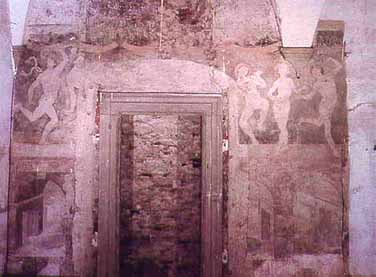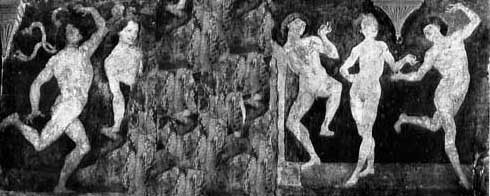La Danza di nudi di Antonio del Pollaiolo (1460-75)
Un’ipotesi di riconoscimento di modelli iconografici antichi tratti dai sarcofagi dionisiaci ellenistico-romani
Marianna Gelussi
English abstract | Compendium

Antonio del Pollaiolo, Danza di nudi, pittura su muro, 1460-75, Villa la Gallina, Arcetri (Firenze)











da sinistra
Danzatore A, sarcofago, 140-150 d.C., Vaticano, Cortile Ottagonale (vedi la serie Danzatore A)
Danzatore B, sarcofago, III secolo, Dresda, Staatliche Skulpturensammlung (vedi la serie Danzatore B)
Danzatore C, sarcofago, fine II secolo, Nuneaton (Warwickshire), Arbury Hall (vedi la serie Danzatore C)
Danzatore D, sarcofago, II secolo, Roma, Casino Rospigliosi (vedi la serie Danzatore D)
Danzatore E, sarcofago, periodo tardo adrianeo-primo antoniniano, Roma, Museo delle Terme (vedi la serie Danzatore E)
La Danza di nudi di Villa la Gallina ad Arcetri (Firenze), dipinta da Antonio del Pollaiolo tra il 1460 e il 1475, rappresenta una danza estatica ‘all’antica’ e costituisce un esempio iconografico unico nella Firenze di metà Quattrocento.
La critica del secolo scorso ha analizzato queste pitture soffermandosi specialmente sullo studio dell’origine della composizione in rapporto all’arte antica, legame apparso immediatamente evidente, sia per il carattere della danza che per la nudità delle figure, per la loro disposizione a ‘fregio’ e per il contrasto, creato dal loro chiarore contro lo sfondo scuro, tipico delle pitture vascolari antiche.
Basandosi su queste considerazioni di carattere per lo più stilistico, i diversi studi indicano alternativamente, quali fonti di ispirazione per l’artista fiorentino, o i motivi dipinti sui vasi greci o quelli a figure rosse dei vasi etruschi, ma senza cercare mai di sostenere puntualmente, su dati di disponibilità verificati dalle fonti, la derivazione dai modelli antichi.
Non è mai stata approfondita la possibilità che le fonti iconografiche a disposizione di Antonio del Pollaiolo potessero essere le rappresentazioni dionisiache scolpite sui sarcofagi ellenistico-romani, il repertorio classico a cui gli artisti fiorentini del Quattrocento guardavano sempre con assiduità e dal quale traevano le forme che segnarono l’irruzione del movimento e dell’espressività ‘all’antica’ nella pittura ‘moderna’ rinascimentale.
Solo Eve Borsook, nel 1980, rileva, a margine di un lavoro sulla pitture murali fiorentine, la corrispondenza posturale tra le figure del fregio della Gallina e quelle di alcuni baccanti raffigurati sui sarcofagi ellenistico-romani.
Uno studio sistematico del repertorio decorativo dei sarcofagi a rappresentazioni dionisiache ha permesso di identificare con una buona dose di approssimazione i ‘tipi’ dai quali derivano le posture delle figure dipinte alla Gallina. Ogni danzatore deriva da una tipologia precisa di baccante così come veniva rappresentato nell’antichità ma, diversamente da come appare sui sarcofagi, viene ritratto completamente nudo e deprivato degli attributi tipici del corteo dionisiaco.
I ‘tipi’ ripresi da Antonio del Pollaiolo ricorrono sistematicamente all’interno delle decorazioni dei sarcofagi dionisiaci, la cui composizione avveniva come una sorta di collage di figure ‘standard’ tratte da un repertorio fisso ‘di bottega’ e riprodotte serialmente. Solo per uno dei danzatori – il terzo del fregio – dobbiamo ricorrere a un originale unico: si tratta del sarcofago proveniente da Orvieto e conservato alla Arbury Hall, perché noto e copiato da altri artisti fiorentini coevi ad Antonio del Pollaiolo e di cui rimane testimonianza anche in un disegno di Cassiano Dal Pozzo oggi alla Royal Library di Windsor.
Per ognuna delle figure dipinte dall’artista fiorentino a Villa la Gallina possono essere invece indicati più modelli tratti da diversi esemplari antichi noti. È proprio il carattere tipologico dei danzatori, la presenza di una ‘serie’, oltre che la specularità evidente delle figure dipinte da Antonio rispetto ai modelli presentati, a legittimare questa ipotesi di derivazione e a rendere in un certo modo secondaria l’identificazione del modello preciso studiato da Antonio, poiché egli prese ispirazione solo da alcuni degli esemplari della serie tra loro perfettamente equivalenti, all’epoca noti.
Riferimenti bibliografici
- Battisti 1981
E. Battisti, Villa la Gallina ad Arcetri: la danza dopo il bagno, in Cicli pittorici. Storie profane, Milano 1981, pp. 98-99. - Borsook 1980
E. Borsook, Antonio del Pollaiuolo. Frieze of Nude Dancers, in The Mural painters of Tuscany from Cimabue to Andrea del Sarto, Oxford 1980, pp. 111-113. - Chastel 1959
A. Chastel, Arte e umanesimo a Firenze al tempo di Lorenzo il Magnifico, [Paris 1959] tr. it. Torino 1964, pp. 68-76. - Cipriani 1980
G. Cipriani, Il mito etrusco nel Rinascimento fiorentino, Firenze 1980, pp. 15-36. - Clark 1959
K. Clark, Il nudo. Uno studio della forma ideale, [Washington 1956] tr. it. Milano 1959, p. 197. - Cocke 1984
R. Cocke, Art and Politics in a Drawing by Antonio Pollaiuolo, “Master drawings” XXII, 1984, pp. 173-177. - Colacicchi 1943
G. Colacicchi, Antonio del Pollaiolo, Firenze 1943, p. XXI. - Cruttwell 1900
M. Cruttwell, The Pollaiuolo, London 1900, pp. 115-116. - Fusco 1979
L. Fusco, Pollaiuolo’s Use of the Antique, "Journal of the Warburg and Courtauld Institutes" XLII, 1979, pp. 257-263. - Logan 1897
M. Logan, Découverte d’une fresque de Pollaiolo, "Cronique des Arts", 1897, pp. 343-344. - Mansfield 1922
M. Mansfield, A Family of Decent Folk. 1200-1741, Firenze 1922, p. 83. - Matz 1968
F. Matz, Die dionysischen Sarkophage, Berlin 1968. - Nocentini
S. Nocentini, Sculture greche etrusche e romane del Museo Bardini in Firenze, Roma 1965, p. 23. - Ortolani 1948
S. Ortolani, Il Pollaiolo, Milano 1948, p. 76. - Pons 1994
N. Pons, I Pollaiolo, Firenze 1994, p. 18. - Sabatini 1944
A. Sabatini, Antonio e Piero del Pollaiolo, Firenze 1944, p. 32. - Shapley 1919
F. R. Shapley, A Student of Ancient Ceramics, Antonio Pollaiuolo, "The Art Bulletin" II, 1919, pp. 78-86. - Van Marie 1929
R. Van Marle, Antonio and Piero del Pollaiuolo and their Followers, in The development of the Italian schools of painting, XI, The Hague 1929, p. 342. - Vickers 1977
M. Vickers, A Greek Source for Antonio Pollaiolo’s Battle of the Nudes and Hercules and the Twelve Giants, "The Art Bulletin" LIX, 1977, pp. 182-187. - Warburg 1966
A. Warburg, L’ingresso dello stile ideale anticheggiante nella pittura del primo Rinascimento (1914), in La rinascita del paganesimo antico, [Leipzig-Berlin 1932] tr. it. Firenze 1966, p. 297.
Abstract
A theoretical recognition of Dionysian iconography from antiquity taken from Hellenistic-Roman sarcophagi
The Danza di Nudi in Villa Gallina in Arcetri (Florence), painted by Pollaiolo between 1460 and 1475 depicts an ecstatic dance all'antica, and is a unique example of iconography in the middle of the fifteenth century. Critics during the last century analysed these paintings, dwelling particularly on the origins of the composition in relation to the art of antiquity, a connection which was blatantly apparent both because of the dance and the nudity of the figures and their frieze-like arrangement, and because of the contrast created by their clarity against a dark background, typical of vase painting in antiquity. These mainly stylistic considerations indicate alternative sources of inspiration for the artist: either the painted motifs on Greek vases or the red figures of Etruscan vases. These studies, however, on the evidence available from the sources, make no attempt at establishing definitively that the inspiration is derived from ancient models. The possibility that the iconographic sources available to Antonio Pollaiolo could have been the Dionysian images sculpted on Hellenistic-Roman sarcophagi which supplied the repertory of classical forms Florentine artists increasingly sought during the Quattrocento, and from which they took those forms that signalled the irruption of movement and expressiveness all'antica in modern Renaissance painting, has never been fully explored, although Eve Borsook, in her work on Florentine wall-painting (1980), observes the postural similarity between the figures in the frieze in Villa Gallina and those of some Bacchantes on the Hellenistic-Roman sarcophagi. A systematic analysis of the decorative repertory on the sarcophagi with Dionysiac images has made it possible to identify with a fair dose of approximation the types from which the postures painted in Villa Gallina derive. Each of the dancers derives from a precise typology of Bacchante as represented in antiquity, but unlike the way they appear on the sarcophagi, they are depicted naked and without the attributes typical of the Dionysian retinue. The types that have been taken up by Pollaiolo can been seen systematically within the decorative schemes of the sarcophagi which were composed like a collage of standard figures taken from a fixed workshop repertory and were produced in serial fashion. Only in the case of one dancer is it necessary to resort to one single sarcophagus - the sarcophagus that comes from Orvieto and is now preserved at Arbury Hall, because it was known and copied by other Florentine artists contemporary with Pollaiolo, evidence of which can be seen in the drawing by Cassiano dal Pozzo, in the Royal Library at Windsor. For each of the figures painted by Pollaiolo in Villa Gallina one can find several drawn from various well-known ancient models. It is precisely the typology of the dancers, the presence of a series, as well as the obvious specularity of the painted figures by Pollaiolo in relation to the models represented, that legitimises our hypothesis of their derivation, and that makes the identification of the precise model studied by Pollaiolo of secondary importance because he took his inspiration only from a few of the examples of the series which match perfectly and were known at the time.
Compendium
Iconographica exemplaria a Dionysiacis sarcophagis Hellenistico-Romanis descripta
Nudorum saltatio quam Pollaiolus ad Florentiam, in villa Gallinavulgo dicta, pinxit inter annum 1460 et 1475 aesthaticam saltationem veterum ex more repraesentat, quod unicum exemplar iconographicum apud Florentinos medio saeculo XV fuit. Superioris saeculi studiosi has imagines examinaverunt, id maxime spectantes, ut, antiquorum quoque artibus collatis, originem dispositionis repeterent. Haec cum antiquis quanta continerentur cognatione facile intellegi poterat ex animo saltantium, e nuditate, e dispositione, ex splendore figurarum obscuris recessibus repugnante, quod picturis antiquorum vasorum maxime consentaneum fuit. Quantum debuisset Pollaiolus vasis sive Graecis sive Etruscis saepe scriptum est, certis tamen exemplaribus silentio praeteritis. Nemo vero umquam coniectaverat Antonium Pollaiolum Dionysiacas imagines Ellenistico-Romanas sarcophagis insculptas iuvisse. Quas Florentini artifices effingere solebant, ea causa ut motum et quasi quendam animum suis operibus inferrent. Haec Eve Borsok anno 1980 prima suspicata est. Hinc factum est ut, sarcophagis Dionysiacis recensis, typi detegerentur quibus nituntur saltantium habitus, quos supra memoravimus. Unusquisque saltatorum ad quandam Bacchicam antiquam typologiam referri potest, praeterquam quod hi recentiores nudi omnino sunt neque signa Dionysiaci comitatus proferunt. Quae exemplaria Pollaiolus in sua opera induxit, ea in Dionysiacis sarcophagis extant. Sarcophagorum vero figurae, quae semper eaedem erant, aliae aliis iuxta ponebantur.
Keywords | Dyonisian Iconography; Renaissance; Pollaiolo
Per citare questo articolo/ To cite this article: M. Gelussi, La Danza di nudi di Antonio del Pollaiolo (1460-75). Un’ipotesi di riconoscimento di modelli iconografici antichi tratti dai sarcofagi dionisiaci ellenistico-romani, ”La Rivista di Engramma” n. 21, novembre/dicembre 2002, pp. 7-12 | PDF